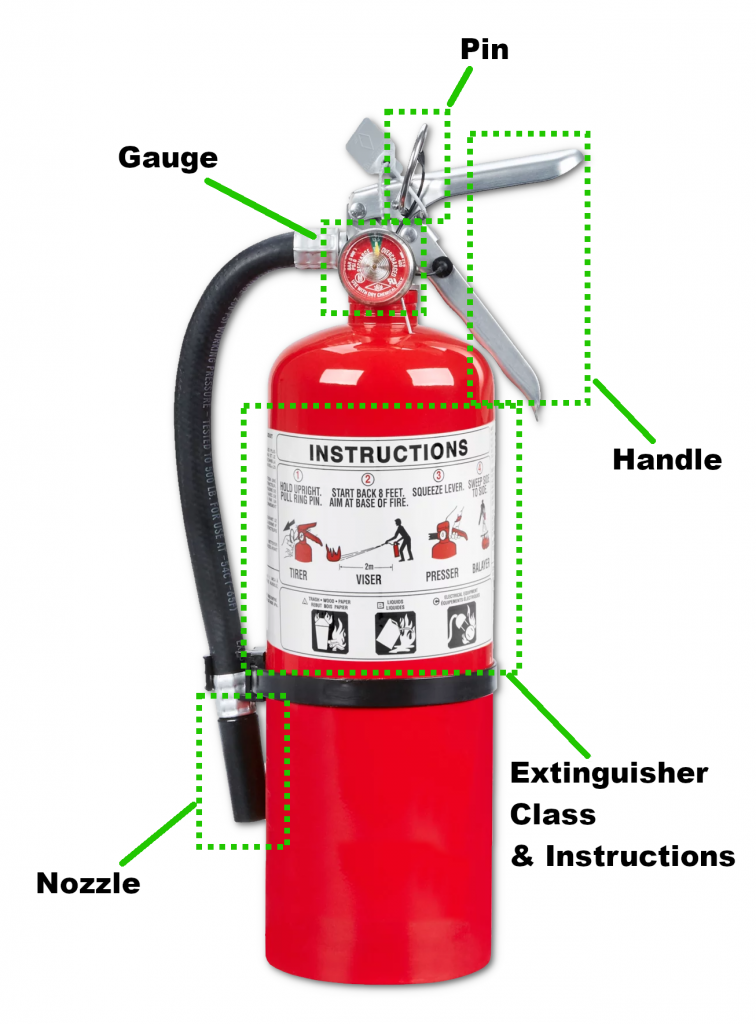Where Should You Have Extinguishers?
It is recommended that you have at least three fire extinguishers easily accessible in your home: one in the kitchen, one in the basement, and one in any garage or storage area. It is also recommended to have one near any fireplace, woodstove, or furnace. Remember to keep them easily accessible, but make sure they are not directly next to any ignition source, as they might not be reachable in the event of a fire.
For businesses and places of work, regulations are in place to ensure a safe environment for employees and customers alike. For more information regarding Fire Code regulations and requirements for Fire Extinguishers, please contact us at (613) 332-2442.
Read the Instructions on Your Extinguisher for Proper Use.
Create a picture in your mind that will reflect the instructions on the extinguisher: if there’s a fire, get everyone outside and ask a member of your family to call the fire department from a neighbour’s house. Only then should you permit yourself to fight a small fire. Keep a distance of about 2 meters away from the fire, and make sure you are positioned between the fire and your escape. Never move to a position where the fire is between you and your way out. Using the extinguisher, spray the base of the fire closest to you and not the top of the flames. If the fire becomes large, get out. Close doors behind you to slow the spread of the fire.
For businesses and places of work, it is recommended that all employees participate in basic training on the use of fire extinguishers, as well as annual refresher courses to ensure everyone will be able to use an extinguisher effectively in cases of emergency.
The ABCD’s of Portable Fire Extinguishers
A fire extinguisher is a storage container for an agent like water or chemicals. It is designed to put out a small fire, not a large one. Extinguishers are labelled ABC or D. Ensure you use the right extinguisher for the appropriate type of fire.
- Ordinary Combustibles – Fires started with paper, wood, drapes and upholstery require a Class A type extinguisher.
- Flammable and Combustible Liquids – Fires originating from fuel oil, gasoline, paint, grease in a frying pan, solvents and other flammable liquids require a Class B type extinguisher.
- Electrical Equipment – Fires started with wiring, overheated fuse boxes, conductors, and other electrical sources require a Class C type extinguisher.
- Metals – Certain metals such as magnesium and sodium require a special dry powder Class D type extinguisher.
A multi-purpose dry chemical labelled ABC puts out most types of fires: wood, paper, cloth, flammable liquids and electrical fires. If you intend to buy more than one, you may want to purchase a BC for the kitchen, an A for the living room and an ABC for the basement and garage.
Buying and Maintaining an Extinguisher
- Extinguishers come in a dry chemical, foam, carbon dioxide, water, or Halon form. Whatever type you buy, it should be labelled by a nationally recognized testing laboratory.
- The higher the number rating on the extinguisher, the more fire it puts out. High rated extinguishers are often (not always) the heavier models. Ensure you can hold and operate the one you buy comfortably.
- Ask your dealer how to have your extinguisher serviced and inspected. Recharge it after ANY use. A partially used extinguisher might as well be empty.
- Extinguishers should be installed near an escape route and away from potential fire hazards.
Learn How to PASS
The easiest way to remember how to use a fire extinguisher is to remember the acronym “P.A.S.S.”
- Pull the pin. Some units require the releasing of a lock latch, pressing a puncture lever, inversion or other motion.
- Aim the extinguisher nozzle (horn) at the base of the fire.
- Squeeze or press the handle.
- Sweep from side-to-side at the base of the fire and discharge the contents of the extinguisher.
Foam and water extinguishers require slightly different use. Read the instructions.
Want to test your knowledge?
Take our short quiz here and see how you score!
